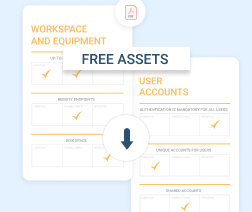It’s easy to get too complacent with any security, and nowhere is this truer than cybersecurity. Cyberattacks can occur at almost any time, anywhere, in any quantity. Attackers are often relatively safe from consequences and free to use failed cyberattacks as learning experiences for their next attempts.
If you run an MSP, you probably know this all too well. Overseeing several customers with differing security needs requires constant adaptation as current threats evolve and new threats emerge. Adopting a proactive cybersecurity model is the easiest and least risky way to achieve this adaptation.
Staying ahead of the curve
Being at the cutting edge of cybersecurity best practices is necessary for you to succeed in today's increasingly complex threat landscape. Implementing traditional security controls, such as email filters, firewalls, and antivirus software, is no longer an effective approach at preventing the types of attacks that hackers are deploying. While these security controls are still necessary, they're not proactive; they only react to incoming attacks at a time when a more aggressive approach is needed. Being proactive with cybersecurity measures is a better strategy for you to implement in 2024.
The poster pack includes:
- Best practices for creating strong passwords
- Reminders on how secure passwords should look like
- A chart to check if your password is secure enough


Improving security controls
Implementing proactive cybersecurity strategies, including the increasingly popular zero-trust model, and the right advanced cybersecurity solution can save you and your customers all kinds of trouble. Some of the features to look for in cybersecurity solutions in today’s market are prevention and detection for zero-day attacks, multi-factor authentication (MFA), automated patch management, immutability, and monitoring and alerting.
Another effective method of finding room for improvement is to hire "ethical hackers” to find weak points and spot vulnerabilities in your customers’ systems and networks. If these experienced professionals find a way in, or even come close, you know where to improve. The better the hackers, the more effective this method can be.
Network testing and monitoring can be extremely beneficial, too. Network monitoring is generally an automated service that tracks traffic in a network across devices, notifying you of any suspicious traffic or vulnerabilities it comes across. Some network monitoring services also monitor the integrity of files within the network, which can help find vulnerabilities.
Accounting for human error
Human error is still the largest threat to an organization. Improving your cybersecurity awareness training in any way may benefit your customers more than any other method listed here. These improvements can involve increasing the frequencies of these trainings, improving the teaching methods used in the training sessions, or assessing employees’ understanding following the training sessions.
One way to test the effectiveness of cybersecurity training in a company is by conducting internal phishing simulations. These simulations involve sending fake phishing emails to employees to see who falls for the scam and clicks on a malicious link or provides sensitive information.
Anything that helps you understand what to improve without actually succumbing to a cyberattack is proactive cybersecurity. Not only is there always room for improvement in your cybersecurity frameworks, but there is also always room for improvement in the methods you use to test them.
- Cloud and local backups protection
- Backup and recovery operations
- How to use backup software to centralize backup operations

About the author
Kurt Abrahams is the Vice President of Marketing at MSP360 with expertise in technology marketing, cybersecurity and AI based technology.






